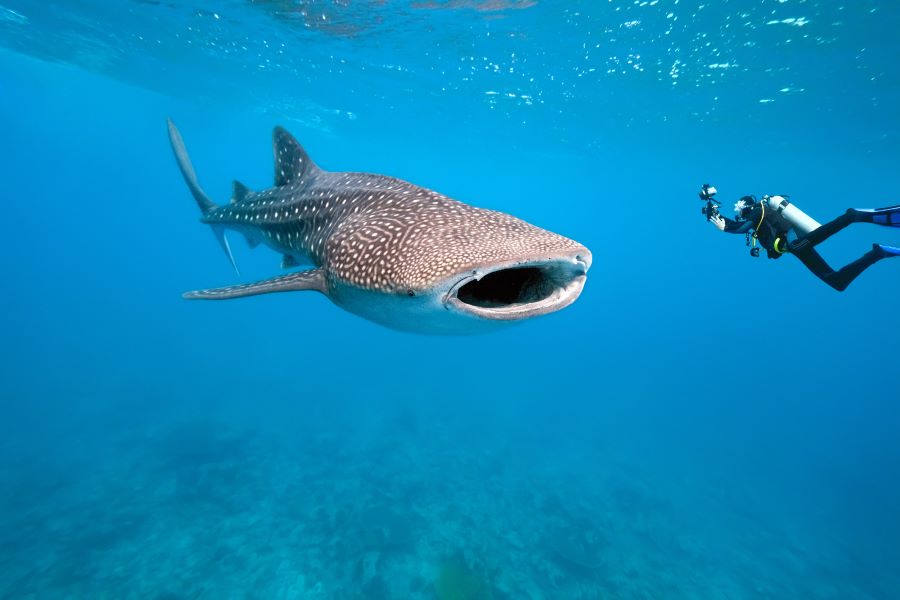I didn’t expect to fall in love with underwater photography. I mean, sure—I love the ocean, I enjoy snorkeling, and I’ve always admired the vibrant, otherworldly beauty of marine life. But taking good photos underwater? That sounded complicated, technical, and something best left to professionals with huge cameras and full scuba gear.
That was until I swam with a whale shark in Sumbawa.
That moment changed everything. And what followed was an unexpected journey—one that took me from shaky GoPro clips to capturing some of my all-time favorite images under the sea.
The Day It All Began: Whale Shark in Clear View
Saleh Bay was where it started.
I’d joined a morning tour with a small group, and the guide told us this area was known for peaceful whale shark sightings. I wasn’t sure what to expect. I had my waterproof camera, a basic snorkel, and a heart racing with excitement.
We slid into the water, and within minutes, there it was—a massive, spotted silhouette gliding beneath the surface. A real whale shark. Majestic. Calm. Almost unreal.
I aimed my camera, barely able to hold it steady, and snapped away like a tourist in Times Square.
Surprisingly, one of those first shots turned out perfect.
📸 Photo 1: “First Contact”
How I Took It:
- Equipment: GoPro HERO10 on a floating grip
- Settings: Wide angle, 1080p, burst photo mode
- Technique: I floated calmly and waited instead of chasing. I tilted the camera slightly upward as the whale shark moved towards the surface light.
Why I Love It: The sun rays filtered through the blue water like stage lights, catching the gentle giant mid-glide. No edits needed.
That photo still gives me chills.
Learning Through Mistakes (and Accidental Genius)
Underwater photography has its own set of challenges: poor visibility, moving subjects, floating particles, and—let’s not forget—your own buoyancy. In the beginning, I made every mistake possible. Foggy lenses. Crooked shots. Too much splash.
But I also discovered a few happy accidents that turned into brilliant images.
📸 Photo 2: “The Bubble Trail”
Taken while adjusting my snorkel, the photo accidentally captured a burst of bubbles swirling past a school of fish in the background. It wasn’t planned, but it looked ethereal—almost dreamlike.
Lesson Learned: Keep the camera rolling, even during transitions. The sea is full of surprises.
Where the Magic Happened: Sumbawa’s Blue Kingdom
Saleh Bay isn’t just about whale sharks. It’s a living canvas of color and movement. I captured coral gardens, swarms of silver fish, curious jellyfish, and shadows of sea turtles passing in the distance.
This place transformed how I see underwater life.
And honestly, I owe some of my best shots to the peaceful waters of this bay. Calm conditions made it easier to stabilize shots and wait patiently for the perfect moment.
If you’ve never been to a Saleh Bay whale shark tour, you’re missing out on a one-of-a-kind experience. It’s not only about the whale sharks—it’s the full, slow, cinematic immersion into Sumbawa’s marine wonderland.
📸 Photo 3: “Face to Face”
There’s one photo where the whale shark’s eye is visible, almost curious about me. I was floating still, allowing it to glide past when I tilted the lens just enough to capture a side view.
Equipment Tip: You don’t need a DSLR in a housing. A well-angled GoPro or waterproof compact camera, combined with patience and soft lighting, can do wonders.
Bonus: Use red filters if diving deeper—they help restore natural color lost in blue water.
Tools That Helped Me Capture Better Underwater Photos
While skills improved over time, having the right tools made a huge difference. Here’s what worked best:
- Wrist Strap: Trust me, the ocean has claimed many devices. Don’t let your camera become another casualty.
- Anti-fog Inserts: Especially useful when shooting for long periods. Fog ruins a perfect moment.
- Float Handle: Acts as a stabilizer and ensures your camera floats if dropped.
- Burst Mode / Time-lapse: Lets you choose the best frame from dozens of shots.
Whale Sharks: The Ultimate Subjects
Out of all the marine life I’ve photographed, whale sharks remain the most majestic. They’re huge, yes—but so gentle. Watching one cruise beside you feels like swimming next to a living zeppelin.
What makes whale shark Sumbawa experiences so memorable is how accessible and respectful they are. You’re not chasing them. You’re observing. Floating nearby. Letting them move on their terms.
That’s how I captured my favorite image of all time.
📸 Photo 4: “Shadow and Light”
In this shot, the whale shark blends into a streak of dark ocean, with sunlight slashing across its back. It looked like a scene from a nature documentary. Completely unedited.
I waited nearly 20 minutes floating still, ignoring every distraction, just for that one shot.
Was it worth it?
Absolutely.
Tips If You Want to Try Underwater Photography in Saleh Bay
- Respect the Wildlife: No flash, no touching, no chasing. Let the animal lead.
- Focus on Composition: Think of your frame like a painting—use contrast, symmetry, and movement.
- Don’t Over-Edit: Some of the best shots are natural. Let the light and colors speak.
- Shoot in Bursts: You’ll get 10 bad photos, but maybe one masterpiece.
How Saleh Bay Made Me a Better Photographer
Before this trip, I thought taking great photos required complex gear. But now, I realize the ocean gives you everything you need. The textures, the light, the patterns—all you have to do is wait and watch.
What made the difference wasn’t just the place. It was the feeling. There’s something humbling about floating above a whale shark. The silence. The grace. The enormity of it.
That emotion translated into every photo.
📸 Photo 5: “The Blue Silence”
Taken in the quiet aftermath of a whale shark encounter, the last photo from my trip shows nothing but ripples, fading bubbles, and deep cobalt blue.
It sounds like nothing, but it feels like everything.
